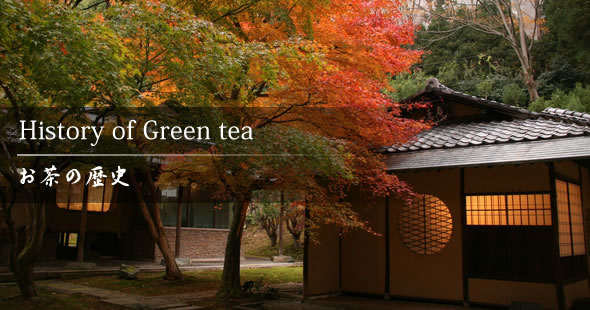History of Green Tea

History of Green Tea
Family: Theaceae (tea)
Green Tea is an ancient and potent tonic that is believed to boost the immune system. It is said to possess potent antibacterial, antiviral and anticarcinogenic properties, and the Chinese have used this natural antioxidant for centuries to revitalize and prolong life. Green Tea is also rich in fluoride and may reduce tooth decay.

History:
It is said that a Chinese emperor who lived five thousand years ago was boiling water when a sudden gust of wind swept some leaves from the branches of a nearby small tree and dropped them into his kettle. The leaves turned the hot water a deep, rich color and released an enticing aroma, which the emperor cautiously tasted - and the great cultural and social tradition of Tea drinking was born in China. Tea has been used as a medicinal beverage to promote health of mind and body since that time and was even recorded as a medicinal aid in China as early as 2737 B.C. Green, Oolong and Black teas are the true teas derived from the same tea plant; they are simply processed differently. Although these are the principal categories of Tea, the Chinese classify tea (cha) with as many as 330 kinds. The Tea plant is an evergreen shrub or tree that is native to the rainy forests of Southeast Asia and may grow to thirty feet, but is usually maintained at a height of five feet by regular pruning. It has been cultivated in Burma, India, Japan, Turkey, Malawi, Argentina, Sri Lanka, Pakistan, Africa and China, where it has been consumed as a beverage and medicinal tonic for five thousand years. The production process that produces Green Tea does not allow oxidation to take place, and because it is not "fermented," the active constituents remain unaltered and stronger. Green Tea is high in polyphenols that are said to possess potent antioxidant and anti-carcinogenic properties. The catechin in the polyphenols called epigallocatechin gallate (EGCG) is said to be over two-hundred-times more powerful than the known antioxidant, vitamin E, in neutralizing free radicals. Most of the Tea produced in the world is Black Tea, with only twenty percent processed as Green Tea, which is primarily consumed in China, Japan and a few countries in North Africa and the Middle East. Several of the constituents included in Green Tea are astragalin, volatile oils, beta-carotene, beta-sitosterol, caffeine, cinnamic acid, eugenol, isoquercitrin, lutein, lycopene, procyanidins, quercetin, rutin, salicylic acid, tannic acid, amino acids/methylxanthines (theophylline, theobromine and theanine), calcium, iron, magnesium, manganese, phosphorus, potassium, zinc, B-vitamins, tacopherol and vitamin C. The primary constituents of interest are the polyphenols, which include flavanols, flavandiols, flavonoids and phenolic acids. Most of the polyphenols in Green Tea are flavonols, commonly known as catechins. Some major Green Tea catechins are (-)-epigallocatechin-3-gallate (EGCG), (-)-epigallocatechin (EGC), (-)-epicatechin-3-gallate (ECG), (-)-epicatechin (EC), (+)-gallocatechin, and (+)-catechin (5). The polyphenols are believed to be responsible for most of Green Tea’s role in promoting good health.


History:
It is said that a Chinese emperor who lived five thousand years ago was boiling water when a sudden gust of wind swept some leaves from the branches of a nearby small tree and dropped them into his kettle. The leaves turned the hot water a deep, rich color and released an enticing aroma, which the emperor cautiously tasted - and the great cultural and social tradition of Tea drinking was born in China. Tea has been used as a medicinal beverage to promote health of mind and body since that time and was even recorded as a medicinal aid in China as early as 2737 B.C. Green, Oolong and Black teas are the true teas derived from the same tea plant; they are simply processed differently. Although these are the principal categories of Tea, the Chinese classify tea (cha) with as many as 330 kinds. The Tea plant is an evergreen shrub or tree that is native to the rainy forests of Southeast Asia and may grow to thirty feet, but is usually maintained at a height of five feet by regular pruning. It has been cultivated in Burma, India, Japan, Turkey, Malawi, Argentina, Sri Lanka, Pakistan, Africa and China, where it has been consumed as a beverage and medicinal tonic for five thousand years. The production process that produces Green Tea does not allow oxidation to take place, and because it is not "fermented," the active constituents remain unaltered and stronger. Green Tea is high in polyphenols that are said to possess potent antioxidant and anti-carcinogenic properties. The catechin in the polyphenols called epigallocatechin gallate (EGCG) is said to be over two-hundred-times more powerful than the known antioxidant, vitamin E, in neutralizing free radicals. Most of the Tea produced in the world is Black Tea, with only twenty percent processed as Green Tea, which is primarily consumed in China, Japan and a few countries in North Africa and the Middle East. Several of the constituents included in Green Tea are astragalin, volatile oils, beta-carotene, beta-sitosterol, caffeine, cinnamic acid, eugenol, isoquercitrin, lutein, lycopene, procyanidins, quercetin, rutin, salicylic acid, tannic acid, amino acids/methylxanthines (theophylline, theobromine and theanine), calcium, iron, magnesium, manganese, phosphorus, potassium, zinc, B-vitamins, tacopherol and vitamin C. The primary constituents of interest are the polyphenols, which include flavanols, flavandiols, flavonoids and phenolic acids. Most of the polyphenols in Green Tea are flavonols, commonly known as catechins. Some major Green Tea catechins are (-)-epigallocatechin-3-gallate (EGCG), (-)-epigallocatechin (EGC), (-)-epicatechin-3-gallate (ECG), (-)-epicatechin (EC), (+)-gallocatechin, and (+)-catechin (5). The polyphenols are believed to be responsible for most of Green Tea’s role in promoting good health.

According to a study published in the Journal of the American Medical Association, Green Tea is associated with decreased early death, from all causes, including cardiovascular disease. Interestingly, these results were not linked with other types of tea, like oolong or black tea, indicating the antioxidants specific to Green Tea could be the cause.


History of Green Tea

0 comments:
Post a Comment